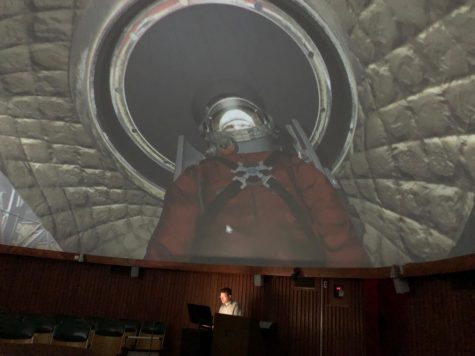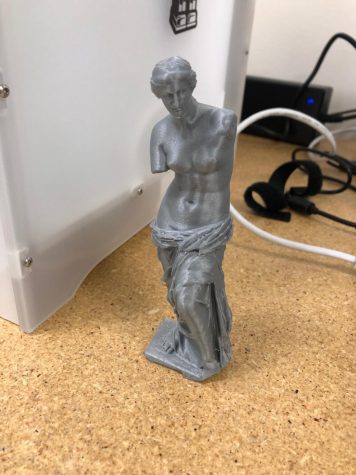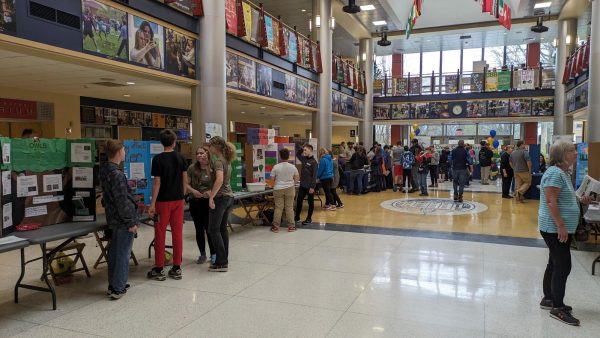Innovation and creativity
New lab brings departments together
“Unusual combinations” is a concept heavily embraced at Allegheny College — as stated in the 2014-15 Allegheny College Viewbook, it celebrates the uniqueness of Allegheny students.
That is exactly what this collaborative of professors had in mind when they created the new Allegheny Lab for Innovation and Creativity.Most of the new lab lives in the Doane Hall of Art, while the other portion is located in Carr Hall room 121.

Professor Jamie Lombardi stands under the dome as the new projector displays video on Tuesday, Sept. 17, 2019, in Carr Hall.

One of the finished products of the new 3D printer sits in the Doane Hall of Art on Tuesday, Sept. 17, 2019.
The ALIC Lab consists of 25 student workstations that can be utilized for video and sound editing, programming and virtual reality software for graphic design projects and serves as a robotics lab.
The fabrication side of the lab has four 3D printers, a laser cutter and a large computer numerical control machine. A CNC machine is like a computer control machine that is used to take precise drawings and cut them out of various materials like wood, foam or metal.
There is also a full dome projector that has found a home with the Physics Department in Carr Hall.
One notable aspect of the ALIC Lab is that any Allegheny student has access to it. The lab is not limited to specific departments.
Byron Rich, assistant professor of art and director of the Art, Science, and Innovation Department, is the coordinator of all lab operations.
“This lab is designed for any student on campus,” Rich said. “Originally, it was designed to be something for (communication arts), art and computer science (students). Then we started reaching out to other departments across campus and made it far more inclusive so any student across campus can come and work in this lab.”
This idea of a new lab had been discussed a few times at Allegheny in the past two decades. It was first proposed in 1997, but never moved further than the proposal phase.
Rich started to reinvigorate the proposal when he arrived at Allegheny in 2014. It wasn’t until a year and a half ago that Rich and a team comprised of various other professors were given the go ahead to start production of the lab.
Michael Mehler, the chair of the communication arts department,was one of the original people working on the proposal in the ’90s and early 2000s.
He also played a role on the team responsible for the production of the current ALIC.
After pushing for this idea since the ’90s,“The timing couldn’t be better,” Mehler said.
“There’s a curricular movement to draw connections between a range of art and science programs,” Mehler said. “ALIC will provide a workspace in which faculty, staff and students from the entire college can work alongside each other to experiment and create.”
Allegheny received a $150,000 grant in April 2019 from the George I. Alden Trust to purchase the full dome projector.
Several members of the Development Office were also pioneers for getting the funds for this new technology purchased, according to Professor of Physics Jamie Lombardi. These members include Diana Brautigam, director, foundation and corporate relations; Heather Grubbs, associate director, foundation and corporate relations; and Kate Bennett, office coordinator, foundation and corporate relations.
Rich and Lombardi took their ideas for a two-part lab as well as a full dome projector, and consolidated them into one grant and one facility (even though they are in two different buildings).
“We hope that people in the Art Department, both faculty and students, will get involved with immersive art displays,” Lombardi said. “You can imagine the artist creating something that is shown in full 360 degrees and surrounds the people who the artist wants to show the display to.”
The projector sends light outward and bounces it off of mirrors to actually project the video onto the dome. The video is a 360-degree shot video that is formatted into a fisheye lens to make it fit the circular format of the dome ceiling.
The software used to create such videos can be found in varying parts of campus, and now the new ALIC lab computers haveaccess to that specialized formatting as well.
The lab is going to be a “hub for interdisciplinary learning,” according to Rich.
“We will have visiting artists, visiting physicists or visiting scholars from all over the place eventually working in the lab and working with students,” Rich said.
The lab is implementing a series of short courses free to students. These courses aren’t being offered for credits, but rather to further one’s learning on a specific software, editing style or even to educate oneself on how to use the new technology available to them, such as the 3D printers.
The courses are also being introduced for those students who can’t fit a full course into their schedules, but have a peaked interest in the subject.
The courses will start in November and will run a few times a month for a few hours at a time. Topics for the courses will be made available to students soon, before November.
What might this collaboration between multiple departments across campus look like for students and professors?
“I think it will do more for students than any of us can begin to imagine,” Mehler said. “There have already been connections forged among art, theatre, video production, and computer science. Once students from other departments find their way into the lab, we’ll really begin to see student-driven innovation.”






